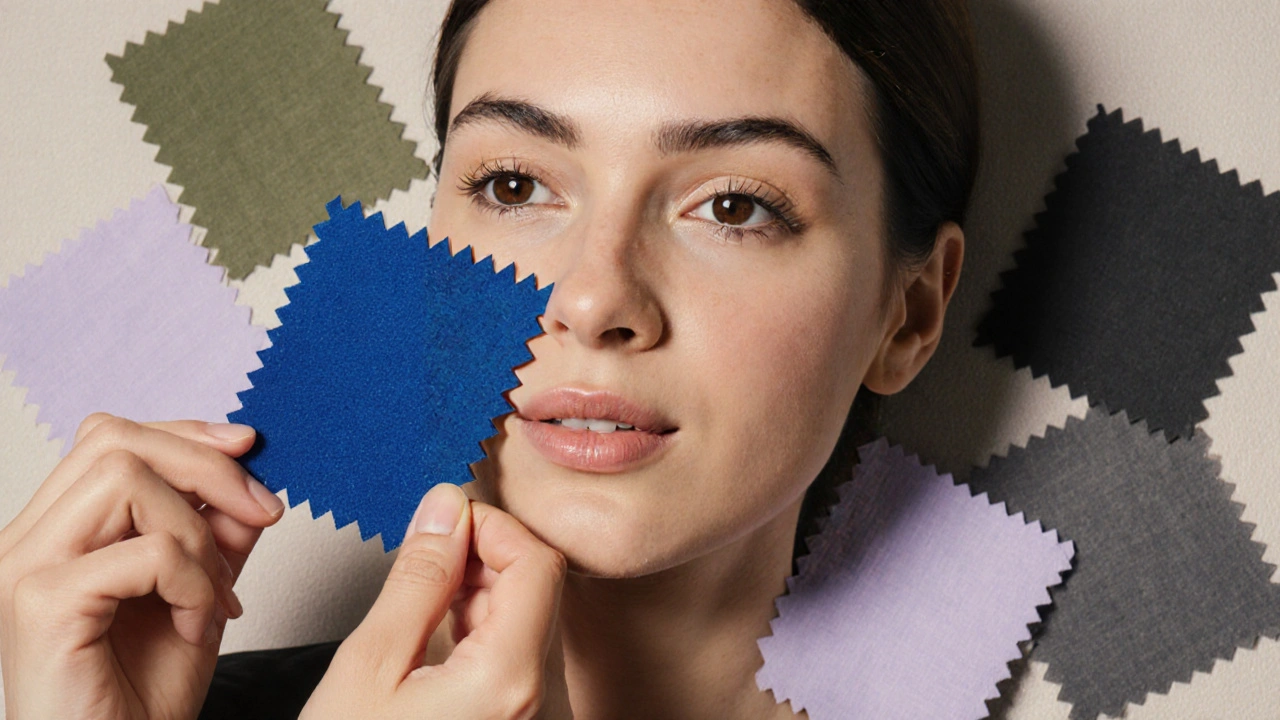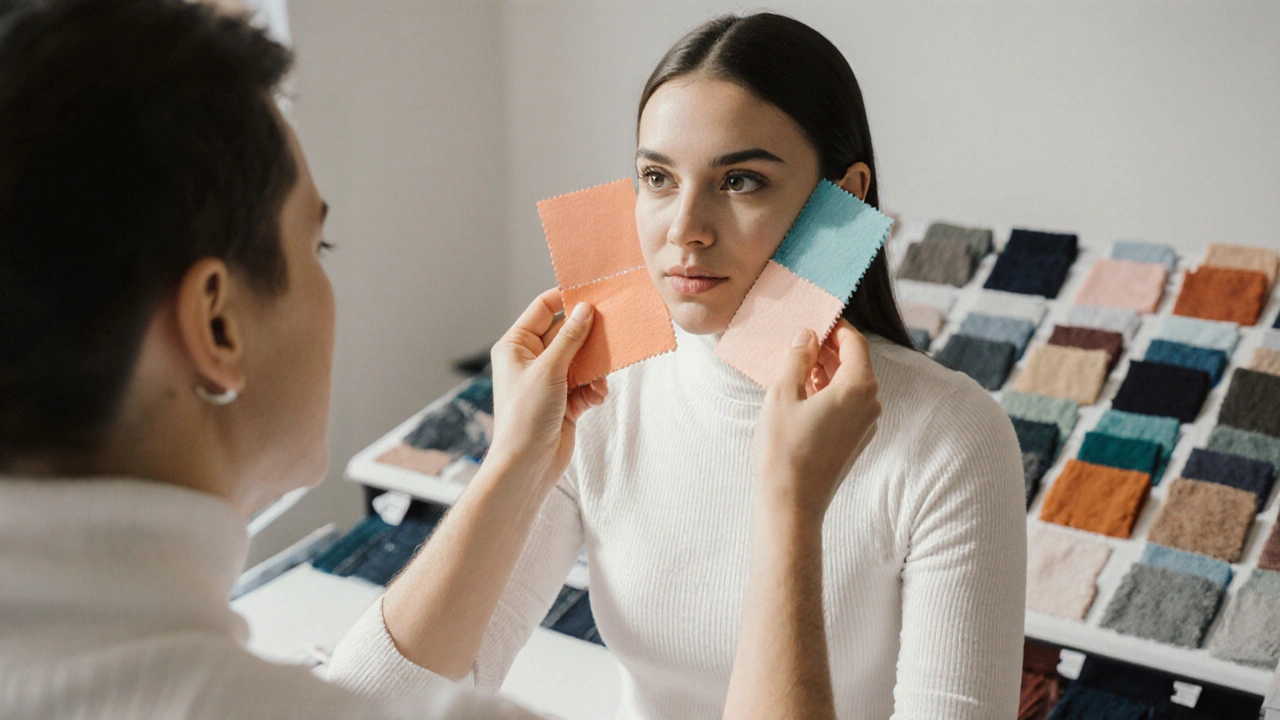Most people think their favorite colors are just a matter of taste. But if you’ve ever bought a shirt that looked great in the store and awful at home, or felt like your makeup always looks muddy, you’re not alone. The problem isn’t your taste-it’s that you haven’t found your true seasonal color type. And the most accurate way to find it? Fabric draping.
What Is Fabric Draping?
Fabric draping is a professional color analysis method where a trained analyst places swatches of fabric-carefully chosen to represent the full spectrum of seasonal colors-against your face, neck, and décolletage. The goal? To see which colors make your skin glow, brighten your eyes, and reduce shadows under your eyes. It’s not about what you like. It’s about what your body actually responds to.
This isn’t a DIY test you can do with a smartphone filter or a Pinterest board. It’s a controlled, in-person process developed by color consultants over decades. Unlike online quizzes that ask you to pick between ‘warm’ and ‘cool,’ fabric draping uses real fabric with known pigments. These swatches are calibrated to reflect light exactly like natural skin tones do under daylight.
The technique was refined in the 1970s by Carole Jackson, who mapped out the 12-season color system. Today, top color analysts use 80-120 swatches, each with specific undertones: true reds, soft peachy pinks, muted olives, deep charcoal grays, and icy blues. The right fabric doesn’t just look good-it changes how your whole face looks.
Why Fabric Draping Beats Online Quizzes
Online color quizzes rely on assumptions. They ask: ‘Do you look better in gold or silver?’ or ‘Do your veins look green or blue?’ But those cues are unreliable. Lighting, makeup, even the screen you’re using can throw off the results. I’ve seen people take five different online tests and get five different seasons: Spring, Summer, Autumn, Winter, and ‘Neutral.’ That’s not a result-it’s confusion.
Fabric draping removes guesswork. The swatches are held directly against your skin, in natural daylight, with no makeup. The analyst watches for subtle changes: Does your skin look more even? Do your eyes pop? Does your jawline appear sharper? These are physiological responses, not opinions.
For example, someone who thinks they’re a ‘Summer’ might look washed out in soft lavender swatches-but suddenly glow when a cool, deep teal is placed near their face. That’s not luck. That’s your natural coloring matching a specific pigment range. That’s how you know you’re a True Winter, not just a ‘cool-toned’ person.
The 12-Season System Explained
The modern seasonal color system breaks down into 12 categories, grouped into four main seasons-Spring, Summer, Autumn, Winter-each split into three subtypes: Bright, Soft, and Deep.
- Spring: Warm undertones, light to medium depth. Think golden skin, green or hazel eyes, strawberry blonde or honey brown hair.
- Summer: Cool undertones, light to medium depth. Fair or porcelain skin, blue or gray eyes, ash blonde or cool brown hair.
- Autumn: Warm undertones, medium to deep depth. Olive or golden skin, amber or brown eyes, auburn or chestnut hair.
- Winter: Cool undertones, medium to deep depth. High contrast skin, blue or dark brown eyes, jet black or icy blonde hair.
Each subtype adds nuance:
- Bright: High saturation, vivid colors (e.g., Bright Spring, Bright Winter)
- Soft: Muted, desaturated tones (e.g., Soft Summer, Soft Autumn)
- Deep: Dark, rich pigments (e.g., Deep Autumn, Deep Winter)
There’s no such thing as a ‘neutral’ season. Everyone falls into one of these 12. Even if you think you’re ‘balanced,’ fabric draping will reveal whether your neutrality leans warm or cool, light or dark.

What Happens During a Fabric Draping Session
A typical session lasts 60 to 90 minutes. You sit in natural light-preferably near a window with no artificial lighting. You wear a plain white or gray turtleneck so the fabric is the only color on you. The analyst starts with neutral swatches: soft gray, beige, and cream. These establish your baseline.
Then they move to warm tones: peach, gold, olive, coral. You’ll feel a difference immediately. Some colors make your skin look tired. Others make you look like you just woke up refreshed. The analyst notes which ones cause your eyes to appear brighter or your cheeks to flush naturally.
Next come cool tones: icy pink, navy, charcoal, plum. Again, you’ll notice which ones make you look vibrant and which ones make you look dull or sallow. The key isn’t what you think looks nice-it’s what your body reacts to. If a color makes your fine lines more visible or your eyes look dull, it’s not your season.
By the end, you’ll have 3-5 swatches that consistently enhance your appearance. These become your personal color palette. You’ll know exactly which blues, greens, reds, and neutrals work for you-no more guessing.
How Your Color Type Affects Your Wardrobe
Once you know your season, your shopping changes. You stop buying ‘blue’ and start buying ‘True Winter Blue’-a deep, icy cobalt that doesn’t turn your skin gray. You stop wearing ‘beige’ and start wearing ‘Soft Autumn Beige’-a warm, slightly golden neutral that doesn’t make you look washed out.
For example, someone who’s a Soft Summer might spend years avoiding bright colors because they think they’re ‘too bold.’ But when they try a Soft Summer coral-a muted, dusty rose-pink-they realize they’ve been avoiding the exact shade that makes them look alive. Suddenly, their entire wardrobe makes sense.
It’s not about being limited. It’s about being empowered. You start buying clothes with confidence because you know why something works. You stop wasting money on things that don’t suit you. You stop feeling like you ‘can’t pull off’ certain colors. You just know what does.
Common Mistakes People Make
Even after a professional session, people often mess up their color choices. Here are the top three mistakes:
- Confusing brightness with saturation: Bright Spring and Bright Winter both use vivid colors, but Bright Spring is warm and light, while Bright Winter is cool and dark. Mixing them leads to clashing.
- Using ‘neutral’ as an excuse: Black and white aren’t universal. Deep Winter looks great in pure black. Soft Summer looks washed out in stark white. Your season determines which neutrals work.
- Ignoring undertones in makeup: If you’re a Warm Autumn, a cool-toned pink lipstick will make you look sick. Your lipstick must match your skin’s undertone-not your mood.
The biggest mistake? Assuming your hair color defines your season. Many brunettes think they’re Autumn. Many blondes think they’re Spring. But hair color changes with age, dye, and lighting. Your skin and eyes don’t lie.

What to Expect After Your Session
You’ll get a printed color fan with your 12-15 best swatches, labeled with your season. You’ll also get a guide showing which colors to avoid and why. Many analysts give you a shopping list: specific Pantone codes, fabric names, and even brand recommendations that match your palette.
Within weeks, you’ll notice changes. Your clothes will fit better-not in size, but in harmony. You’ll feel more confident walking into a room. You’ll stop second-guessing your outfits. You’ll start noticing how others dress differently now-and why some people just look ‘put together’ without trying.
This isn’t vanity. It’s precision. Just like wearing the right shoe size prevents blisters, wearing the right colors prevents visual fatigue-for you and everyone around you.
Where to Find a Professional Fabric Draping Analyst
Not all color analysts are created equal. Look for someone certified by the Color Me Beautiful or Kellerman Color Analysis programs. Avoid anyone who uses only 10-20 swatches or claims you’re ‘between seasons.’ True analysis uses at least 80 swatches and gives you one clear season.
Most analysts work in studios, but some offer in-home services. Sessions cost between $150 and $400, depending on location and experience. It’s not cheap-but think of it as an investment. If you’ve spent $5,000 on clothes that don’t suit you, this pays for itself in one season.
Check reviews for consistency. Good analysts don’t just tell you your season-they explain why. They show you the swatches side by side. They let you feel the difference. If they rush you or use a phone photo to ‘analyze’ you, walk away.
Final Thought: Color Is a Language
Color isn’t just about aesthetics. It’s a silent language your body speaks every day. When you wear the right colors, your skin glows, your eyes brighten, your energy lifts. When you wear the wrong ones, you look tired, older, or dull-even if you’re sleeping well and eating right.
Fabric draping gives you the dictionary to read that language. It doesn’t change who you are. It just helps you show up as the most vibrant version of yourself.
Can I do fabric draping at home?
You can try, but you won’t get accurate results. Home lighting, phone cameras, and uncalibrated fabric swatches distort color. Professional analysts use daylight-matched swatches and controlled environments. What looks flattering on your phone screen won’t look the same in real life. For true accuracy, in-person analysis is necessary.
How long does a fabric draping session last?
Most sessions take between 60 and 90 minutes. This includes time to remove makeup, test swatches in natural light, observe reactions, and explain your results. Some analysts offer extended sessions with wardrobe styling tips.
Do I need to wear makeup during the session?
No. You should arrive with no makeup, or with minimal, neutral foundation. The goal is to see your natural skin tone, undertones, and how colors interact with your actual skin-not your makeup. Analysts often ask you to remove makeup before starting.
Can my seasonal color type change over time?
Your underlying seasonal color type doesn’t change. But aging, sun exposure, or drastic hair color changes can affect how your colors appear. For example, gray hair can make a Warm Autumn look cooler. That’s why some people get refitted after 10-15 years. But your core season remains the same.
Is fabric draping worth the cost?
Yes-if you’ve ever spent money on clothes you never wore. The average person wastes over $1,000 a year on mismatched colors. A $300 session can save you thousands over a decade by helping you buy only what truly works. It’s not an expense-it’s a wardrobe upgrade.


Write a comment